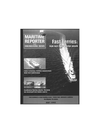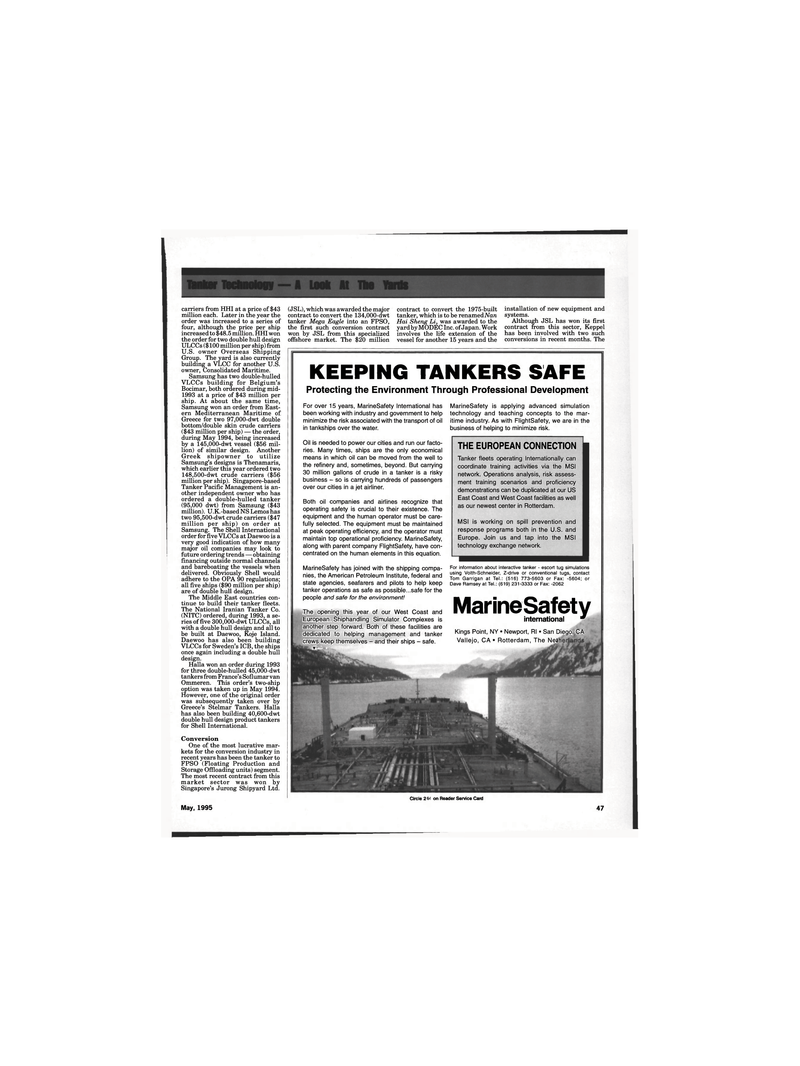
Page 45: of Maritime Reporter Magazine (May 1995)
Read this page in Pdf, Flash or Html5 edition of May 1995 Maritime Reporter Magazine
carriers from HHI at a price of $43 million each. Later in the year the order was increased to a series of four, although the price per ship increased to $48.5 million. HHI won the order for two double hull design
ULCCs ($100 million per ship) from
U.S. owner Overseas Shipping
Group. The yard is also currently building a VLCC for another U.S. owner, Consolidated Maritime.
Samsung has two double-hulled
VLCCs building for Belgium's
Bocimar, both ordered during mid- 1993 at a price of $43 million per ship. At about the same time,
Samsung won an order from East- ern Mediterranean Maritime of
Greece for two 97,000-dwt double bottom/double skin crude carriers ($43 million per ship) — the order, during May 1994, being increased by a 145,000-dwt vessel ($56 mil- lion) of similar design. Another
Greek shipowner to utilize
Samsung's designs is Thenamaris, which earlier this year ordered two 148,500-dwt crude carriers ($56 million per ship). Singapore-based
Tanker Pacific Management is an- other independent owner who has ordered a double-hulled tanker (95,000 dwt) from Samsung ($43 million). U.K.-basedNSLemoshas two 95,500-dwt crude carriers ($47 million per ship) on order at
Samsung. The Shell International order for five VLCCs at Daewoo is a very good indication of how many major oil companies may look to future ordering trends — obtaining financing outside normal channels and bareboating the vessels when delivered. Obviously Shell would adhere to the OPA 90 regulations; all five ships ($90 million per ship) are of double hull design.
The Middle East countries con- tinue to build their tanker fleets.
The National Iranian Tanker Co. (NITC) ordered, during 1993, a se- ries of five 300,000-dwt ULCCs, all with a double hull design and all to be built at Daewoo, Koje Island.
Daewoo has also been building
VLCCs for Sweden's ICB, the ships once again including a double hull design.
Halla won an order during 1993 for three double-hulled 45,000-dwt tankers from France's Soflumar van
Ommeren. This order's two-ship option was taken up in May 1994.
However, one of the original order was subsequently taken over by
Greece's Stelmar Tankers. Halla has also been building 40,600-dwt double hull design product tankers for Shell International.
Conversion
One of the most lucrative mar- kets for the conversion industry in recent years has been the tanker to
FPSO (Floating Production and
Storage Offloading units) segment.
The most recent contract from this market sector was won by
Singapore's Jurong Shipyard Ltd. (JSL), which was awarded the major contract to convert the 134,000-dwt tanker Mega Eagle into an FPSO, the first such conversion contract won by JSL from this specialized offshore market. The $20 million contract to convert the 1975-built tanker, which is to be renamedMm
Hai Sheng Li, was awarded to the yard by MODEC Inc. of Japan. Work involves the life extension of the vessel for another 15 years and the installation of new equipment and systems.
Although JSL has won its first contract from this sector, Keppel has been involved with two such conversions in recent months. The
KEEPING TANKERS SAFE
Protecting the Environment Through Professional Development
For over 15 years, MarineSafety International has been working with industry and government to help minimize the risk associated with the transport of oil in tankships over the water.
Oil is needed to power our cities and run our facto- ries. Many times, ships are the only economical means in which oil can be moved from the well to the refinery and, sometimes, beyond. But carrying 30 million gallons of crude in a tanker is a risky business - so is carrying hundreds of passengers over our cities in a jet airliner.
Both oil companies and airlines recognize that operating safety is crucial to their existence. The equipment and the human operator must be care- fully selected. The equipment must be maintained at peak operating efficiency, and the operator must maintain top operational proficiency. MarineSafety, along with parent company FlightSafety, have con- centrated on the human elements in this equation.
MarineSafety is applying advanced simulation technology and teaching concepts to the mar- itime industry. As with FlightSafety, we are in the business of helping to minimize risk.
THE EUROPEAN CONNECTION
Tanker fleets operating Internationally can coordinate training activities via the MSI network. Operations analysis, risk assess- ment training scenarios and proficiency demonstrations can be duplicated at our US
East Coast and West Coast facilities as well as our newest center in Rotterdam.
MSI is working on spill prevention and response programs both in the U.S. and
Europe. Join us and tap into the MSI technology exchange network.
Circle 203 on Reader Service Card
For information about interactive tanker - escort tug simulations using Volth-Schneider, Z-drive or conventional tugs, contact
Tom Garrigan at Tel.: (516) 773-5603 or Fax: -5604; or
Dave Ramsey at Tel.: (619) 231-3333 or Fax: -2062
MarineSafety international *
Kings Point, NY • Newport, Rl • San Diego, CA
Vallejo, CA • Rotterdam, The Net
MarineSafety has joined with the shipping compa- nies, the American Petroleum Institute, federal and state agencies, seafarers and pilots to help keep tanker operations as safe as possible...safe for the people and safe for the environment!
The opening this year of our West Coast and
European Shiphandling Simulator Complexes is another step forward. Both of these facilities are dedicated to helping management and tanker crews keep themselves - and their ships - safe. i • -v..,...
May, 1995 47

 44
44

 46
46
